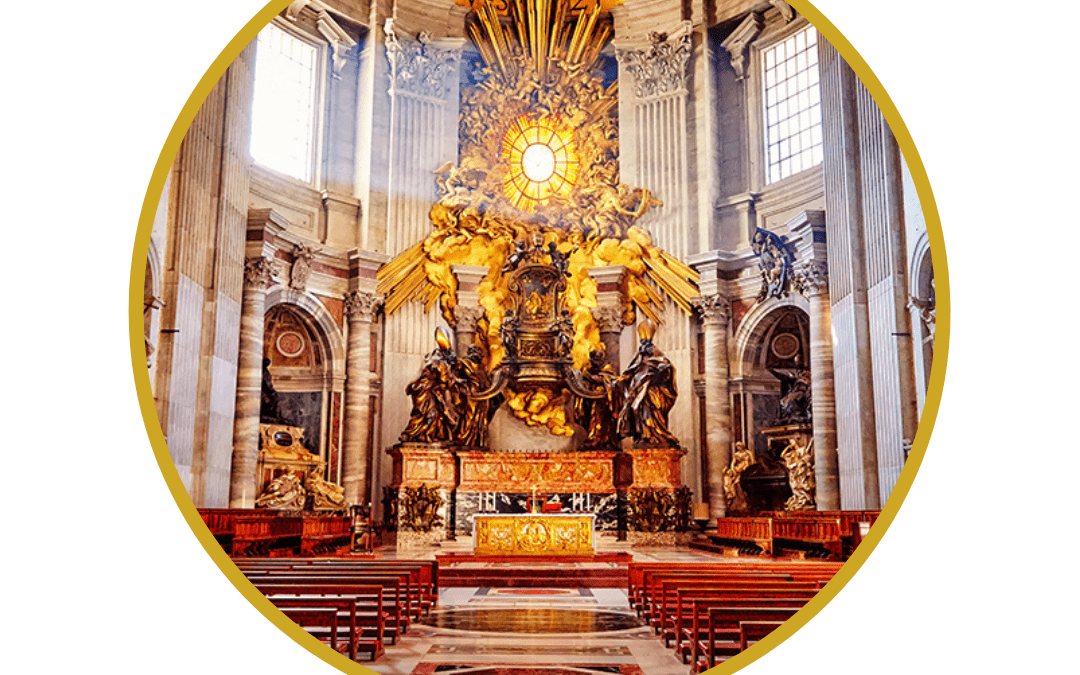22 February: Feast of the Chair of Saint Peter. While it may seem like a strange feast, the church is not just celebrating a piece of furniture today. This Feast has been celebrated since the early Church and has multifold meaning. First, it does refer to the actual chair that Peter sat on as the first pope. Officials in the Roman Empire would sit on chairs for official work. This tradition was replicated in the Church. Cathedra is Latin for “chair” or “throne” and denominates the chair or seat of a bishop, hence “cathedral” denominates the bishop’s church in an episcopal see. The physical “chair of Peter” is encased in a sculpture designed by Bernini located in Saint Peter’s Basilica in Rome. In the apse of the Basilica, a great bronze throne encloses the wooden chair from the ninth century, believed to be Peter’s own chair. On the chair itself, Bernini depicts three scenes from Peter’s life: the giving of the keys (symbolizing authority to lead the Church), the washing of feet (symbolizing Peter’s office is one of service), and Jesus’ instruction to “Feed my sheep” (pointing to Peter’s role as teacher and guide). Below the chair are statues of four doctors of the Church (Saints Athanasius, John Chrysostom, Ambrose, Augustine). Above the throne is an oval window with the Holy Spirit depicted as a dove. The symbolism of this great work of art is clear: the Holy Spirit guides the Church through Saint Peter and his successors, who authoritatively teach the Word of God through Sacred Scripture and Tradition. This feast day is also about the spiritual authority bestowed upon Saint Peter by Jesus: “You are Peter, and on this rock I will build my church, and the gates of hell shall not prevail against it. I will give you the keys to the kingdom of heaven, and whatever you bind on earth shall be bound in heaven, and whatever you loose on earth shall be loosed in heaven.” (Matt. 16:18-19). Pope Benedict XVI wrote: “So what was the ‘Chair’ of St Peter? Chosen by Christ as the ‘rock’ on which to build the Church, he began his ministry in Jerusalem… The Church’s first ‘seat’ was the Upper Room, and it is likely that a special place was reserved for Simon Peter in that room where Mary, Mother of Jesus, also prayed with the disciples… Then Peter went to Rome, the center of the Empire… So it is that the See of Rome, which had received the greatest of honors, also has the honor that Christ entrusted to Peter of being at the service of all the particular Churches for the edification and unity of the entire People of God… The See of Rome, after St Peter’s travels, thus came to be recognized as the See of the Successor of Peter, and its Bishop’s ‘cathedra’ represented the mission entrusted to him by Christ to tend his entire flock… Celebrating the ‘Chair’ of Peter, therefore, means attributing a strong spiritual significance to it and recognizing it as a privileged sign of the love of God, the eternal Good Shepherd, who wanted to gather his whole Church and lead her on the path of salvation.” In the fourth century, St. Jerome wrote to Pope Damascus I: “I follow no leader but Christ and join in communion with none but Your Blessedness, that is, with the chair of Peter. I know that this is the rock on which the Church has been built.”
Ideas for celebrating this feast at home:
- Pray the Litany of St. Peter.
- See images of the Chair of Peter here. Read more about the chair here.
- Watch “Peter: Keeper of the Keys” on FORMED
- A symbol for Saint Peter is keys (the keys to the kingdom). A fun feast day activity would be to make keys out of craft supplies, cookie dough, pancake batter, or bread dough.
- Have children to design a “chair” for St. Peter out of pantry supplies (cookies, crackers, nut butters, candies, pretzels, etc). Ideas here and here.
- For dinner, make Baked Rockfish in honor of Peter “the rock” (or any type of fish, since Peter was a fisherman!) Serve it alongside a “Golden Chair of St. Peter fruit salad”
(sources: ncregister.com; simplycatholic.com; www.vaticannews.va; Franciscanmedia.org; edwardsri.com)

Recent Comments